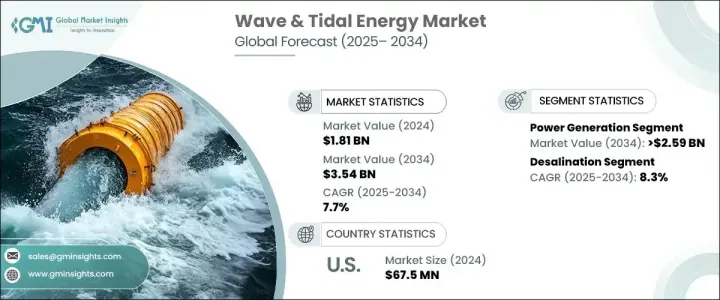 |
市场调查报告书
商品编码
1684638
波浪能和潮汐能市场机会、成长动力、产业趋势分析和 2025 - 2034 年预测Wave and Tidal Energy Market Opportunity, Growth Drivers, Industry Trend Analysis, and Forecast 2025 - 2034 |
||||||
2024 年全球波浪能和潮汐能市场估值达到 18.1 亿美元,预计 2025 年至 2034 年期间将以 7.7% 的强劲复合年增长率成长。波浪能利用主要由风产生的海面波浪的动能和位能,而潮汐能则利用地球、月球和太阳之间的引力交互作用所造成的海平面上升和下降。二者共同代表了再生能源领域一个充满希望的前沿。

随着全球对清洁能源的关注度不断提高,波浪能和潮汐能已成为永续发电的主要贡献者。它们对环境的影响极小,再加上丰富的海洋资源,使它们成为缓解气候变迁的关键解决方案。世界各国政府正透过财政激励、试点计画和补贴等方式积极支持此产业,为技术进步和商业化铺路。能源转换系统、材料和部署技术的创新进一步提高了这些技术的效率和成本效益,吸引了投资者和利害关係人的极大兴趣。
| 市场范围 | |
|---|---|
| 起始年份 | 2024 |
| 预测年份 | 2025-2034 |
| 起始值 | 18.1亿美元 |
| 预测值 | 35.4 亿美元 |
| 复合年增长率 | 7.7% |
预计发电产业将成为该市场的主要驱动力,预计到 2034 年将达到 25 亿美元。技术进步正在提高能源转换效率,使波浪能和潮汐能係统比风能和太阳能等其他再生能源更具竞争力。这些进步不仅促进了技术的采用,而且还促进了再生能源结构的多样化。
在扩大再生能源的强烈推动下,美国波浪能和潮汐能市场预计到 2034 年将创造 1.4 亿美元。政府政策和激励措施(例如美国能源部(DOE)的资助)在这一增长中发挥关键作用。这些倡议包括对研究和开发进行大量投资,特别是旨在证明波浪和潮汐技术的可行性和可扩展性的试点计画。材料和能源转换系统的不断改进,进一步推动了高效且经济的解决方案的部署,使美国成为再生能源转型的领导者。
目录
第 1 章:方法论与范围
- 市场定义
- 基础估算与计算
- 预测计算
- 初步研究与验证
- 主要来源
- 资料探勘来源
- 市场定义
第 2 章:执行摘要
第 3 章:产业洞察
- 产业生态系统
- 监管格局
- 产业衝击力
- 成长动力
- 产业陷阱与挑战
- 成长潜力分析
- 波特的分析
- PESTEL 分析
第四章:竞争格局
- 介绍
- 战略仪表板
- 创新与永续发展格局
第 5 章:市场规模与预测:按应用,2021 – 2034 年
- 主要趋势
- 发电
- 海水淡化
- 其他的
第六章:市场规模及预测:按地区,2021 – 2034 年
- 主要趋势
- 北美洲
- 我们
- 加拿大
- 欧洲
- 法国
- 西班牙
- 英国
- 挪威
- 亚太地区
- 中国
- 印度
- 韩国
- 世界其他地区
第七章:公司简介
- AquaWave & Tidal Power
- BioPower Systems
- CorPower Ocean
- Carnegie Clean Energy
- Eco Wave Power Global
- Inyanga Marine Energy Group
- Minesto
- Nova Innovations
- Orbital Wave & Tidal Power
- Ocean Renewable Power Company
- SINN Power
- SSE Renewables
The Global Wave And Tidal Energy Market achieved a valuation of USD 1.81 billion in 2024 and is projected to grow at a robust CAGR of 7.7% from 2025 to 2034. These renewable energy sources leverage the immense power of water movement, offering a sustainable alternative to traditional energy forms. Wave energy taps into the kinetic and potential energy of ocean surface waves, generated primarily by wind, while tidal energy harnesses the rise and fall of sea levels caused by the gravitational interactions between the Earth, moon, and sun. Together, they represent a promising frontier in the renewable energy landscape.

As the global focus on clean energy intensifies, wave and tidal energy have emerged as key contributors to sustainable power generation. Their minimal environmental impact, coupled with the abundant availability of ocean resources, positions them as critical solutions for mitigating climate change. Governments worldwide are actively supporting this industry through financial incentives, pilot programs, and subsidies, paving the way for technological advancements and commercialization. Innovations in energy conversion systems, materials, and deployment techniques are further improving the efficiency and cost-effectiveness of these technologies, attracting significant interest from investors and stakeholders.
| Market Scope | |
|---|---|
| Start Year | 2024 |
| Forecast Year | 2025-2034 |
| Start Value | $1.81 Billion |
| Forecast Value | $3.54 Billion |
| CAGR | 7.7% |
The power generation segment is expected to be a primary driver for this market, with estimates suggesting it will reach USD 2.5 billion by 2034. The growing urgency to reduce greenhouse gas emissions has made wave and tidal energy a preferred choice for sustainable power solutions. Advances in technology are enhancing energy conversion efficiency, making wave and tidal systems more competitive against other renewable energy sources like wind and solar. These advancements are not only fostering technology adoption but also contributing to the diversification of the renewable energy mix.
The U.S. wave and tidal energy market is projected to generate USD 140 million by 2034, driven by a strong commitment to expanding renewable energy sources. Government policies and incentives, such as funding from the U.S. Department of Energy (DOE), play a pivotal role in this growth. These initiatives include substantial investments in research and development, particularly in pilot projects designed to demonstrate the feasibility and scalability of wave and tidal technologies. Continuous improvements in materials and energy conversion systems are further enabling the deployment of efficient and cost-effective solutions, positioning the U.S. as a leader in the renewable energy transition.
Table of Contents
Chapter 1 Methodology & Scope
- 1.1 Market definitions
- 1.2 Base estimates & calculations
- 1.3 Forecast calculation
- 1.4 Primary research & validation
- 1.4.1 Primary sources
- 1.4.2 Data mining sources
- 1.5 Market definitions
Chapter 2 Executive Summary
- 2.1 Industry synopsis, 2021 – 2034
Chapter 3 Industry Insights
- 3.1 Industry ecosystem
- 3.2 Regulatory landscape
- 3.3 Industry impact forces
- 3.3.1 Growth drivers
- 3.3.2 Industry pitfalls & challenges
- 3.4 Growth potential analysis
- 3.5 Porter's analysis
- 3.5.1 Bargaining power of suppliers
- 3.5.2 Bargaining power of buyers
- 3.5.3 Threat of new entrants
- 3.5.4 Threat of substitutes
- 3.6 PESTEL analysis
Chapter 4 Competitive landscape, 2024
- 4.1 Introduction
- 4.2 Strategic dashboard
- 4.3 Innovation & sustainability landscape
Chapter 5 Market Size and Forecast, By Application, 2021 – 2034 (USD Million & MW)
- 5.1 Key trends
- 5.2 Power generation
- 5.3 Desalination
- 5.4 Others
Chapter 6 Market Size and Forecast, By Region, 2021 – 2034 (USD Million & MW)
- 6.1 Key trends
- 6.2 North America
- 6.2.1 U.S.
- 6.2.2 Canada
- 6.3 Europe
- 6.3.1 France
- 6.3.2 Spain
- 6.3.3 UK
- 6.3.4 Norway
- 6.4 Asia Pacific
- 6.4.1 China
- 6.4.2 India
- 6.4.3 South Korea
- 6.5 Rest of World
Chapter 7 Company Profiles
- 7.1 AquaWave & Tidal Power
- 7.2 BioPower Systems
- 7.3 CorPower Ocean
- 7.4 Carnegie Clean Energy
- 7.5 Eco Wave Power Global
- 7.6 Inyanga Marine Energy Group
- 7.7 Minesto
- 7.8 Nova Innovations
- 7.9 Orbital Wave & Tidal Power
- 7.10 Ocean Renewable Power Company
- 7.11 SINN Power
- 7.12 SSE Renewables








